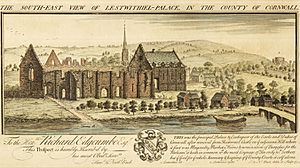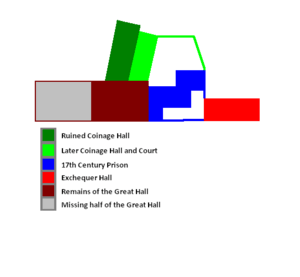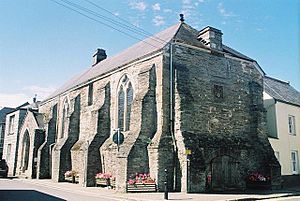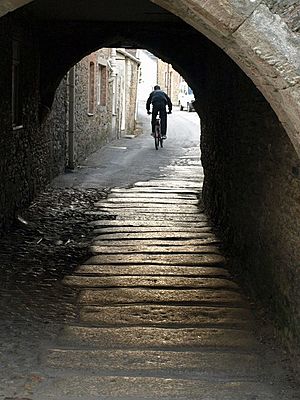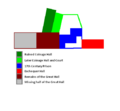Lostwithiel Stannary Palace facts for kids
The Stannary Palace, also known as the Duchy Palace, was a group of buildings built between 1265 and 1300. Powerful rulers called the Earls of Cornwall used it as their main office. It was a very important place for managing the tin mining industry in Cornwall.
One part of the palace, called the exchequer hall, is still standing. People believe it's the oldest non-church building in all of Cornwall! There was also a much bigger building called the Great Hall. It was designed to look like Westminster Hall in London. The Earls and later the Dukes of Cornwall lived at Restormel Castle, so this palace was mainly for official business.
Contents
What Was the Stannary Palace?
The Stannary Palace was a huge complex, covering more than 8,000 square meters (about 2 acres). It had several important parts.
The Great Hall: A Hub for Tin Mining
The Great Hall was the main meeting place for all matters related to the Duchy and the tin mines (called Stannaries). This is where important decisions were made. The palace also had places for smelting tin, where the raw tin ore was melted down. There was a coinage hall too, where tin was weighed and taxed.
Courts and Prisons for Tin Miners
The Stannary Palace was also where the special courts for tin miners were held. These courts dealt with any problems or disagreements in the tin industry. There was even a prison for those who broke the stannary laws. Records show that the entire palace was finished between 1272 and 1300. It was considered the most impressive building in Cornwall at the time.
Who Built the Palace?
In 1265, a powerful man named Richard, who was the Earl of Cornwall, bought Restormel Castle, the town of Lostwithiel, and Fowey. Richard was the second son of King John and the brother of King Henry III. Lostwithiel was a very busy port back then, one of the most important in Cornwall.
When Richard died in 1273, his son Edmund became the new Earl. Edmund moved into Restormel Castle and was responsible for building the Great Hall of the Stannary Palace.
How Did the Palace Change Over Time?
In 1338, the earldom of Cornwall became a dukedom. The first Duke was Edward, the Black Prince. The Stannary Palace then became the main office for the entire Duchy of Cornwall. It was even the only place in Cornwall where people could vote!
The Cornish Rebellion and New Laws
The Cornish tin mining system (Stannaries) was stopped for a while after the Cornish Rebellion of 1497. But King Henry VII brought it back. He did this after the tin miners paid him a very large sum of money, £1,000, to help him fight a war against Scotland.
In 1508, King Henry VII also gave the tin miners a special document called the "Charter of Pardon." This charter said that no new laws affecting miners could be made without the agreement of twenty-four special representatives called "stannators." Six stannators were chosen from each of the four main tin mining areas: Lostwithiel, Launceston, Truro, and Helston.
This charter was very important. It stated that no law passed in London would apply to the Stannaries without the approval of these twenty-four stannators. This showed how much power the tin miners and the Duchy of Cornwall had.
What Happened During the English Civil War?
In September 1644, during the English Civil War, the town of Lostwithiel was taken over by the Earl of Essex. He made it his main base. During the fighting, the town was badly damaged. The Great Hall of the palace was attacked and burned, destroying many important records.
The Exchequer Hall, however, was not as badly damaged. After the war, it became the main meeting hall for the Stannaries and for public gatherings.
The Palace in Later Years
Over the centuries, the palace continued to be important. In 1533, a writer named John Leland noted that Lostwithiel was the county town for Cornwall and had the main Shire Hall. In 1495, King Henry VII ordered that the official weights and measures for Cornwall be kept in Lostwithiel. These weights are still part of the town's old treasures today.
The last meeting of the tin miners' parliament was held in the Hall in 1751. By 1874, the Duchy offices moved to a different location. The entire building was then sold to local business people. The Convocation Hall became a drill hall, and today it is owned by the Freemasons.
Inside the building, you can still see hints of its past. There are traces of a beautiful medieval rose window above the old south entrance. You can also see original oak supports and timbers that have been there for hundreds of years.
At the north end of the building, there is a special Duchy Coat of Arms from around 1650. It shows fifteen gold coins (called bezants) and is believed to be the oldest Duchy Arms in this design. On the very top of the hall's roof, you can see the Prince of Wales' plume of feathers. This was probably put there by the Black Prince himself when he visited Lostwithiel and Restormel Castle in 1353.
Today, parts of the old Stannary Palace are used as homes, an antique shop, and a printing business. The Duchy Palace building at the north end was used as a Masonic Hall until 2008. It was then bought by the Prince's Regeneration Trust, which has started to repair it. The Lostwithiel Town Band currently uses the building while other future uses are being explored.
Images for kids


